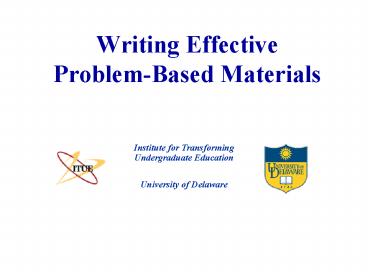Writing Effective ProblemBased Materials - PowerPoint PPT Presentation
1 / 16
Title:
Writing Effective ProblemBased Materials
Description:
Pool balls colliding. Bullets hitting blocks of wood. Traditional End-of ... Final stage written up by group with complete analysis. Reflections and Questions ... – PowerPoint PPT presentation
Number of Views:44
Avg rating:3.0/5.0
Title: Writing Effective ProblemBased Materials
1
Writing Effective Problem-Based Materials
Institute for TransformingUndergraduate Education
University of Delaware
2
Important Considerations in Writing Problems
- Level of course and maturity of students
- Time frame
- Staging
- Availability and access to learning resources
- Use of prompting questions
- Role of problem in accomplishing course
objectives
3
Types of Learning Objectives
- Content-oriented subject specific
- Basic knowledge and understanding of specific
concepts, techniques, etc. in the discipline - Process-oriented global skills
- Effective communication oral and written
- Acquiring and evaluating information
- Working effectively with others
- Higher order, critical thinking
4
What Factors Influence DecisionsAbout Problems?
- Who is the problem writer?
- - discipline
- - control issues
- - level of investment
- What is the course?
- - students (number and level)
- - sequencing of course/problems
- - time/structure of class
5
Step OneIdentify Learning Objectives
- Think of a learning objective in your course .
- How do you usually address this learning
objective? What kind of problem or activity do
you usually assign? - Typical end-of-chapter problem?
- A reading?
- Other?
6
Solving Problems Using Conservation of Momentum
- Traditional examples
- Pool balls colliding
- Bullets hitting blocks of wood
7
Traditional End-of-Chapter Problem
- A 1500-kg car traveling east with a speed of 25
m/s collides at an intersection with a 2500-kg
van traveling north at a speed of 20 m/s. Find
the direction and magnitude of the velocity of
the wreckage after the collision, assuming that
the vehicles undergo a perfectly inelastic
collision (ie, they stick together). - Serway and Faughn. 3rd ed. College Physics,
Saunders, 1992.
8
Step Two Identify Real-World Context
Name a realistic application of the
concept. Outline a scenario.
- Ideas
- Add story-telling to end-of-chapter problem.
- Add motivation, require students to go beyond
rote learning, do research. - Include decision-making.
- Other?
9
A Real Traffic Accident
- Based on police sketch
- Students need to make assumptions and
approximations - Information given
- gradually
- throughout problem
10
Sources and Strategies for Writing Problems
- Newspaper articles, news events
- Popular press in the discipline
- Make up a story based on content objectives
- Adapt a case to a problem
- Research papers
- Other?
11
Step ThreeDraft the problem
Outline the problem.What will be on the first
page?
- Suggestions
- Good PBL problem has multi-page, multi-stage
construction - leave students guessing! - Not all information given in chapter or text -
students look for resources. - Challenge students to come to consensus, reach
conclusions, and make judgments.
12
John Henry - Traffic Cop
- Stage 1 What questions need to be answered?
What measurements, data? What physics principles?
Then initial introduction to momentum. - Stage 2 Sketch given, some information given
students analyze and ask questions. - Stage 3 Outline procedure, make assumptions,
Apply concepts. - Stage 4 Make judgment and rationalize decision
based on physics principles
13
Activities Related to John Henry
- Students summarize each stage before moving to
next. - Final stage written up by group with complete
analysis.
14
Reflections and Questions
15
Presentation of Problem Ideas
- Post your problem ideas in the Problem Ideas
topic in WebCT Discussions - Use the template in WebCT handouts
- Give your idea a unique topic or title as the
subject of your posting - Took a look at several other problem ideas and
offer feedback in WebCT discussions - More time tomorrow a.m. for sharing of ideas and
feedbck
16
Feedback To Presenters
- What did you like most about the problem?
- Does it challenge students to think and do
research? - Is the problem appropriate for the proposed
course?































